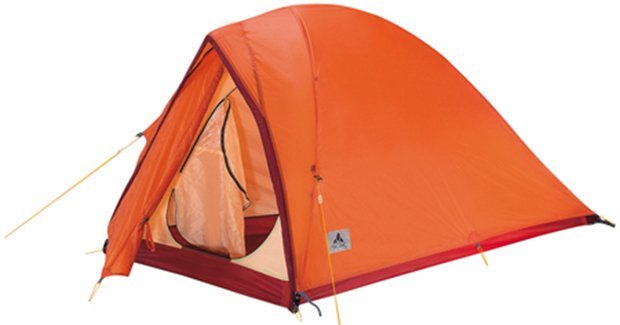Vaude Hogan Ultralight tent

I STUMBLED ACROSS the Vaude Hogan Ultralight in 2006 when working on Australian Geographic Adventure while the editor at the time, Lincoln Hall, was off climbing some hill in the Himalayas. Hall is an inspiring chap and so I deduced that I needed a four-season, lightweight, two-person tent to have some adventures of my own.
The Hogan Ultralight was a very good choice. Not only is it super-light (about 1.8kg), but it has ample room for one person and their gear – I tend to carry a lot of camera equipment so the extra room is appreciated. While the headroom is minimal, it’s enough for me to clean lenses and prepare for another day of shooting.
The front vestibule is on the small side – I’ve cooked in it in bad weather a few times and it’s enough to get by, but you wouldn’t want to be cooped up for too many days. Pitching it is easy, with the single cross pole making life very simple (as long as you have the Vaude badge up – a rookie error I was guilty of). Even in windy conditions, the pitching technique is fast and assured.
The tent inner is made of 30-denier polyester ripstop 285T and simply clips in place. Then the 40D polyamide ripstop 240T fly slides over the top and fastens to squeeze-lock tabs on the floor, which is made of the same material as the fly.
Done, all in about five minutes on a good day. If it’s windy or a weather bomb is about to implode, then I secure the four guy ropes, but they’re not required otherwise.
The tent is a tunnel/ridge design and as long as you point the tail into the wind you’ll hardly notice the gusts. If you’re side-on then the guy ropes will keep the buffeting to a minimum. It is quite easy to relocate the tent once it is up, but we had great difficulty trying to find a way to pitch it with the fly on – this would be very handy for wet weather.
The bathtub floor is laminated and has a hydrostatic head rating of 10,000mm (fly is 3000mm), but it feels thin and light and so I have always used a cheap, rugged ground sheet. Maybe that has something to do with this tent’s longevity?
The build quality is first class – the circular zipper at the entrance is a bit stiff at times, but this is about the only negative. The poles are long when folded and a lot of hikers won’t like this as they won’t pack small across your pack, but I’ve always attached them – sometimes even the whole tent – to the outside of my pack.
The 56cm x 15cm bag has a lot of room for a groundsheet. It could be made better with small compression straps, but it works nicely as it is. For real lightweight walks you’ll probably just pack the tent in your backpack.
RRP $599 www.rucsac.com.au

